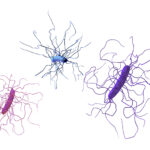Preventing ‘chemo brain’ with antioxidants targeting the spinal fluid

Up to three-quarters of patients receiving cancer chemotherapy suffer from “chemo brain” — a side effect that makes it harder to remember things, maintain attention, and learn new information. When it strikes children, whose brains are still developing, effects are sometimes long lasting, affecting their schoolwork and self-esteem.
“One of the most distressing potential side effects of chemotherapy in children is cognitive loss,” says pediatric oncologist Dr. Lisa Diller, chief medical officer for the Dana-Farber/Boston Children’s Cancer and Blood Disorders Center. “If we had preventive treatments that could be delivered during therapy, or later in the survivorship phase of care, that would be game-changing for families.”
Drs. Maria Lehtinen and Naama Kanarek, in the Department of Pathology at Boston Children’s, have begun investigating the possibility of such a treatment. Their vision: treating the cerebrospinal fluid (CSF) that bathes the brain and spinal cord to protect the brain from chemotherapy’s toxic effects.
“If we can treat the CSF, which is easy to target, we can potentially treat the brain itself,” says Dr. Kanarek.
Investigating chemo’s effects on the brain
Dr. Lehtinen has conducted pioneering studies showing the importance of the CSF in promoting brain health and growth, together with the choroid plexus, the little-known brain tissue that produces CSF. Separately, Dr. Kanarek has been studying the metabolic effects of the chemotherapy drug methotrexate on cancer cells. Methotrexate is used in children with acute lymphoblastic leukemia that has spread to the brain, as well as osteosarcoma and certain tumors of the central nervous system. It is also used in adults to treat leukemia, lymphoma, breast cancer, and lung cancer.

The two labs teamed up on a collaborative study, published in the journal Neuron on September 6 and led by Dr. Ahram Jang in Lehtinen’s lab. They began by studying mice, and found that exposure to methotrexate led to the production of toxic oxygen molecules that caused damage to both the CSF and the choroid plexus.
Nerve cells in the hippocampus, the brain’s main center of learning and memory, were also damaged. And in behavioral testing, the mice showed increased anxiety and impairment on tasks involving short-term learning and memory.
Using advanced laboratory tools, the study further showed that methotrexate prevented the choroid plexus from secreting a key enzyme, superoxide dismutase 3 (SOD3), into the CSF. SOD3 is a natural antioxidant that normally protects cells in the brain and other tissues by helping break down potentially toxic oxygen molecules. The researchers think that without SOD3 delivered by the CSF, brain cells are more susceptible to damage.
Reversing toxic brain effects of methotrexate
Do the same effects happen in humans? The Lehtinen and Kanarek labs first studied human neurons generated from stem cells. When they exposed the neurons to methotrexate, they produced less SOD3 and showed evidence of oxidative damage.
They also studied CSF samples from 11 adult cancer patients who had received methotrexate chemotherapy for lymphomas affecting their central nervous system. Compared with 12 people who were cancer-free and did not receive methotrexate, they had reduced levels of SOD3 in their CSF and an increase in markers of oxidative damage.
So could adding SOD3 back protect the brain? Using a gene therapy approach in the mice, the research team boosted SOD3 production in the choroid plexus. When they then gave the mice methotrexate, the animals’ CSF and brain tissue were largely free of oxidative damage, and there was less evidence of anxiety and memory impairment.
“With more work in the future, these findings have the potential to prevent or treat one of the most concerning late effects of methotrexate, a cancer drug we use frequently,” says Dr. Diller.
Exploring prevention possibilities
Drs. Lehtinen and Kanarek now want to explore the effects of other chemotherapy drugs on the CSF and choroid plexus. They also want to better understand how methotrexate and antioxidants affect other parts of the brain and test the efficacy of antioxidants given directly, rather than through gene therapy, in alleviating chemo brain.
Antioxidant treatments could potentially come in the form of an IV injection, a nasal spray, or an intrathecal injection, through a spinal tap, directly into the CSF. Such treatments could possibly be given together with the chemotherapy itself. The most immediate opportunity might be in patients who are receiving intrathecal methotrexate for brain cancer, or for leukemia or lymphoma with brain involvement, says Dr. Kanarek.
Another potential approach, yet to be tested, is simply providing antioxidants through antioxidant-rich foods or dietary supplements.
“This first study is just the tip of the iceberg,” says Dr. Lehtinen. “If we could correct the collateral damage of chemotherapy and make even a small improvement in the trajectory of patients’ lives, that would be really exciting.”
Learn more about the Childhood Cancer Survivorship Program at Dana-Farber/Boston Children’s.
Related Posts :
-

Exposing a tumor’s antigens to enhance immunotherapy
Successful immunotherapy for cancer involves activating a person’s own T cells to attack the tumor. But some tumors have ...
-

Combining CAR-T cells and inhibitor drugs for high-risk neuroblastoma
Chimeric antigen receptor (CAR)-T cell therapy is a potent emerging weapon against cancer, altering patients’ T cells so they ...
-

Could a GI bug’s toxin curb hard-to-treat breast cancer?
Clostridium difficile can cause devastating inflammatory gastrointestinal infections, with much of the damage inflicted by a toxin the bug produces. ...
-

A new approach to C. diff? Targeting the inflammation, not the bacteria
Clostridium difficile (C. diff) intestinal infections can cause severe, debilitating diarrhea in patients who are hospitalized or on immunosuppressive therapies. ...





